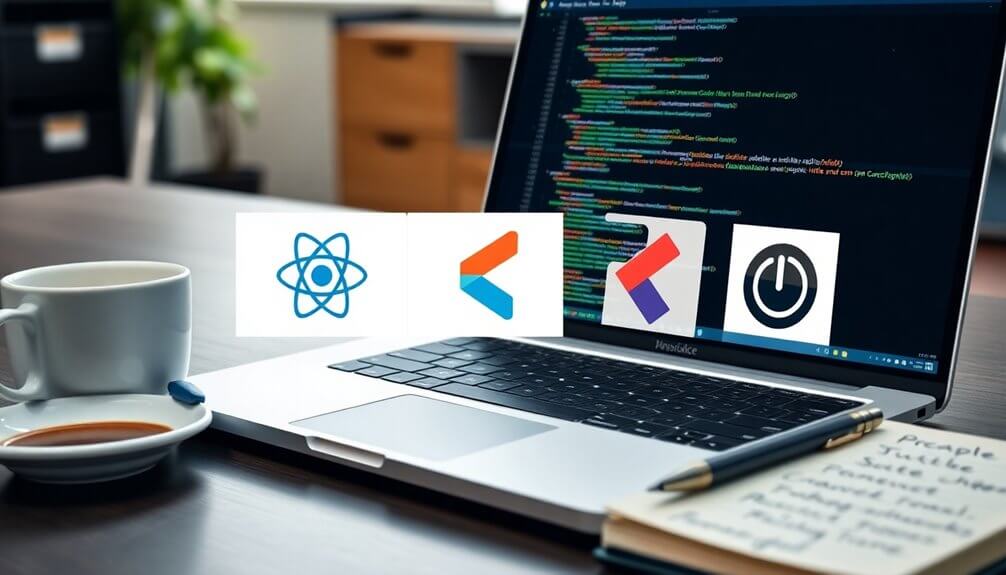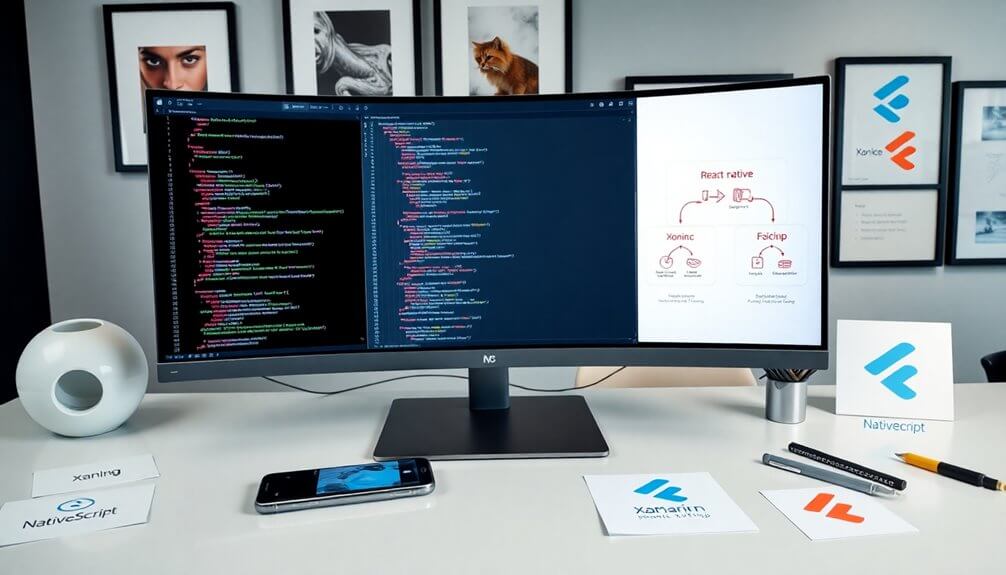When you’re new to mobile app development, choosing the right framework can be overwhelming. You’re tasked with selecting a foundation that will support the entire lifecycle of your app, from building to testing and deployment. With so many options available, it’s vital to understand the differences between native and cross-platform frameworks. Native frameworks are tailored for a single platform, while cross-platform frameworks allow for code reusability across multiple platforms. Your choice will substantially impact the efficiency and success of your project, so let’s break down the key components and types of frameworks to help you make an informed decision.
Key Takeaways
- Mobile app development frameworks are software libraries that provide the fundamental structure for building mobile applications efficiently.
- Types of mobile app frameworks include Native Apps, Web Apps, and Hybrid Apps, each with unique advantages and use cases.
- Key components of frameworks include core library components, APIs, development tools, and UI/UX design elements that streamline the development process.
- Choosing the right framework is crucial for project success, considering factors like performance, cost, and time-to-market.
- Popular mobile app frameworks include Flutter, React Native, Ionic, and Xamarin, each with strengths and weaknesses suitable for different project needs.
Types of Mobile App Frameworks
Native App Frameworks are designed for building apps exclusively for a single platform, such as iOS or Android.
These frameworks use platform-specific programming languages like Swift or Objective-C for iOS and Java or Kotlin for Android.
Native apps offer the best performance and access to device-specific features, making them ideal for high-performance and resource-intensive applications.
Cross-Platform App Frameworks, on the other hand, enable developers to create applications that can run on multiple platforms using a single codebase.
This is a cost-effective approach, as it significantly reduces development time and expenses by leveraging Reusable Code, which is one of the key advantages of cross-platform frameworks.
Frameworks like React Native, Flutter, Xamarin, and Ionic save time and resources by allowing code reuse across different platforms, but may sometimes sacrifice performance compared to native apps.
They’re suitable for projects requiring deployment across multiple platforms. The use of cross-platform frameworks accelerates development by approximately 30% on average.
Understanding these app development types will help you pick the right framework for your needs. Popular cross-platform frameworks like Flutter and React Native are maintained by large companies, such as Google and Facebook.
Key Components of Frameworks
When building a mobile app, you need a framework that streamlines your development process.
Core library components and API integration tools are vital as they provide pre-written code for common tasks and facilitate seamless communication with external services, respectively.
Mobile app frameworks offer a standardized way to build and deploy apps, ensuring consistency across different projects. A well-designed framework should prioritize modularity to allow for independent development and maintenance of different app components.
Mobile app frameworks are categorized into several types, including Native Apps, Web Apps, and Hybrid Apps.
Core Library Components
Core Library Components (Key Components of Frameworks)
Benefits | Description | Advantages |
| —————————– | ——————————————————– | ——————————— |
|---|---|---|
| Pre-built Code | Collections of pre-written code for common tasks. | Saves development time. |
| Consistency | Guarantees uniform code implementation. | Enhances code readability. |
| Reusability | Allows for the reuse of code across multiple apps. | Promotes efficiency and reduces errors. |
Android app development relies on a robust framework that includes four essential app components: activities, services, broadcast receivers, and content providers. These components serve as the building blocks of an Android app, facilitating interactions between the system and users.
Cross-platform frameworks like BeeWare and Kivy can simplify the development process by allowing developers to write code once and compile it for different platforms.
Mobile app development frameworks provide developers with the necessary structure and components to build mobile applications efficiently, using a solid understanding of web-based languages like JavaScript, CSS, and HTML.
API Integration Tools
API integration tools play a critical role in mobile app development frameworks by facilitating seamless data exchange between different software applications and services through APIs.
By leveraging these tools, you can automate workflows, streamline business processes, and enhance functionality by integrating diverse SaaS applications. Key benefits of API integration include efficiency, reliability, and manageability in integrating APIs, along with error handling and data transformation capabilities.
To effectively use API integration tools, you need to understand their key components, such as API gateways, data transformation, error handling, and security features like encryption and two-factor authentication.
Pre-built connectors for popular applications and services also simplify the integration process. When choosing an API integration tool, consider project requirements, scalability, security, ease of use, and cost. Understanding that an API is a set of protocols enabling different software applications to communicate with each other is essential for selecting the right integration tool.
By addressing these factors, you can overcome integration challenges and tap the full potential of your mobile app by seamlessly connecting it with other applications and services. This not only enhances user experience but also streamlines operations, ultimately driving business growth. API integration tools, such as MuleSoft and Zapier, offer comprehensive features for managing and securing APIs.
Additionally, effective API integration is crucial in various mobile app development frameworks such as Flutter and React Native, which emphasize native-like performance and cross-platform compatibility.
Effective API integration is vital for successful mobile app development.
UI/UX Design Elements**
UI/UX Design Elements (Key Components of Frameworks)
UI/UX design elements are at the forefront of mobile app development frameworks, shaping the user experience and elevating the app’s overall aesthetic appeal.
When designing your mobile app, you’ll need to focus on several key components. Responsive Layout guarantees a consistent layout across different screen sizes, while pre-built templates save time by providing common app screens like login and profile pages. Widget libraries offer reusable UI elements such as buttons and sliders, and theming allows for consistent styling throughout the app. Customizable components enable designers to tailor UI elements to specific needs.
To create an engaging user experience, you’ll also need to incorporate UX design principles like simplicity, usability, and accessibility.
This includes using interactive elements like animations, shifts, and feedback mechanisms to enhance user interaction. Additionally, following mobile design trends and incorporating UI patterns like material design guidelines and dark mode integration will help create a cohesive and modern app design. By leveraging these UI/UX design elements in conjunction with a user-centered design approach, you can ensure that your app meets user expectations and delivers a seamless experience.
For instance, some frameworks like Onsen UI, integrate HTML5 and CSS technologies to deliver exquisite mobile UI designs, enabling the creation of impressive experiences with various process frameworks.
Flutter‘s widget-based development is another valuable tool for rapid application development.
Mobile app design is a multidisciplinary field that demands a deep understanding of user behavior and technological constraints, making it essential to consider these factors throughout the design process.
Native Vs Cross-Platform Apps

Native apps offer superior performance, customized design, and seamless integration with device features, but they come with higher development costs and complexity.
On the other hand, cross-platform apps provide cost-efficiency, faster development, and code reusability, but may have slight performance issues and limited access to device-specific features.
Ultimately, the choice between native and cross-platform apps should be based on business and project contexts. The average smartphone user in the United States looks at their mobile device 47 times a day, highlighting the importance of selecting the right app development strategy to engage users effectively.
By 2025, the use of 5G technology is expected to further enhance the performance of native apps with faster network speeds.
Native App Benefits
Developing a mobile app with superior performance, tight security, and a seamless user experience is a top priority for many businesses.
Native apps offer a range of benefits that make them an ideal choice for achieving these goals.
Native App Advantages
When it comes to mobile app development, native apps stand out for their exceptional performance and security features.
They have several key advantages.
* Faster Execution and Platform-Specific Compilation: Native apps are optimized for specific platforms, making them fast and efficient.
They’re compiled using the platform’s core programming language and APIs, enhancing performance.
- Tight Security: Native apps enhance data security by accessing platform-specific built-in security features.
- Quality UX and Full Feature Set Access: Native apps provide a smoother user input and output experience, consistent with the device’s OS interfaces.
They can access all features and functionalities of the device, enhancing the user experience.
* Lower Defect Rates and Stable Support: Native apps have lower defect rates and are less prone to bugs due to direct access to updated SDKs, and they receive stable support from tech giants like Apple and Google.
Native apps are often preferred for their high-performance capabilities which are critical for complex applications requiring intensive processing. Native app development also ensures that these apps are exclusively available on app stores, such as the Apple App Store or Google Play Store, tailored to the OS.
The choice between native and cross-platform development significantly impacts the app’s design, technologies used, and the users who can access it operating system choice.
Cross-Platform Advantages
While native apps excel in performance and security, they require separate development projects for each platform, leading to increased costs and development times.
That’s where cross-platform development shines. By leveraging a single codebase across platforms, you can substantially reduce development costs and time.
With cross-platform development, you’ll enjoy the benefits of code sharing, where one set of code works seamlessly on multiple operating systems.
This not only speeds up the development process but also streamlines maintenance and updates, allowing for synchronized changes across platforms.
Moreover, a single deployment means you can target both Android and iOS markets simultaneously, broadening your reach without multiplying your workload.
Cross-platform development guarantees a consistent brand identity and user experience, despite the differences in platform-specific features.
By choosing cross-platform tools, you can achieve rapid time-to-market, efficient maintenance, and wide audience reach, making it an attractive option for startups and enterprises looking to optimize resources.
Cross-platform frameworks like Flutter demonstrate comparable performance to native apps in regular development scenarios, offering cost-effective scalability.
However, slight performance limitations may occur if native add-ons are over-relied upon.
Cross-platform development also utilizes framework reliance to combine native and shared code, ensuring a more integrated user experience across diverse devices.
The global demand for mobile applications continues to grow, with over 255 billion apps downloaded in 2022 alone, making cross-platform development an essential strategy for meeting this expanding market.
Cross-platform development allows for a shared codebase approach, enabling developers to maintain and update applications more efficiently by working with a single code repository.
Choosing the Right Path**
Choosing the Right Path (Native Vs Cross-Platform Apps)
Complexity and Resource Intensity: If your app requires complete access to phone resources and services, or if it needs to utilize the full capabilities of the phone’s hardware, native development is the way to go.
- Security: Native apps have built-in platform-specific security features and direct support from tech giants like Apple and Google, making them more secure.
- Performance: Native apps are optimized for specific platforms, ensuring they’re fast, efficient, and run smoother compared to cross-platform apps.
- Stability and Updates: Native development guarantees more stability and easier updates due to direct access to SDKs and less dependency on third-party software.
Native apps provide a flawless user experience with smoother input and output, consistent interfaces, and access to all device features, enhancing the overall user experience.
For projects with strict timelines and cost constraints, cross-platform development offers faster time-to-market and lower development expenses.
Furthermore, native apps can function offline, which is a significant advantage over web applications that require an internet connectionOffline Performance.
Consider these factors to make an informed decision about your app development path.
Choosing the Right Framework

Choosing the Right Framework
================================
Selecting the right mobile app development framework is a critical step that can make or break the success of your project. You need to ponder several key factors to verify you choose the best framework for your needs.
Project Requirements and Framework Considerations
- Define project requirements: Clearly outline your app’s target platforms (iOS, Android, or both), necessary features (e.g., GPS, camera integration, payment gateways), budget constraints, and expected development timeline. Understanding the difference in development speed and cost between various frameworks is crucial for making an informed decision.
- Choose between native and cross-platform frameworks: Native frameworks offer high performance and platform-specific features (e.g., Swift for iOS, Kotlin for Android), while cross-platform frameworks provide a broader reach and faster development (e.g., Flutter, React Native).
A mobile app development framework essentially serves as a library that provides the essential framework needed to develop mobile applications tailored to a particular setting.
Comparison of Framework Types
| Framework Type | Key Benefits | Key Challenges |
|---|---|---|
| Native | High performance, direct access to platform-specific features | Higher development time, separate codebases |
| Cross-Platform | Broad reach, faster development, single codebase | Potential performance glitches, limitations in accessing native features |
| Hybrid | Combines web and native components, easier maintenance | Potential performance issues, complexity in integrating native plugins
Popular Mobile App Frameworks

You’re building a mobile app and need the right framework to speed up development and enhance performance. Top frameworks like React Native, Flutter, and Ionic offer unique benefits, such as cross-platform compatibility, native-like performance, and extensive libraries of UI components. The selection of the right framework along with an apt platform and development strategy is crucial for success.
Key Framework Features
Mobile app development frameworks are essential tools for building robust and efficient applications that meet the diverse needs of users across different platforms.
These frameworks offer cross-platform advantages, allowing developers to build apps for multiple platforms using a single codebase, thereby reducing development time and increasing efficiency.
However, they also present native integration challenges, requiring developers to navigate the complexities of native modules and device features.
Key features of popular mobile app frameworks include:
- *React Native*: Built on JavaScript and React.JS for native-like app development, with multi-language support and extensive community support for future modifications.
- *Flutter*: Provides high-performance apps with a rich widget library and hot-reload functionality, boasting a strong community and expanding ecosystem.
- *Ionic*: Develops hybrid and cross-platform mobile apps with a variety of UI elements and seamless deployment processes, integrating with Angular for complex app development.
- *PhoneGap (Cordova)*: Utilizes web technologies like HTML5, CSS3, and JavaScript for app development, supporting native device features and a plugin-able architecture.
Top Framework Choices
Developing a robust and efficient mobile application requires selecting the right framework. You’re faced with numerous options, but understanding the top choices can streamline your decision-making process.
If high performance is your priority, Flutter stands out with its use of Dart and Google’s UI toolkit, adopted by Alibaba and Google’s own apps.
React Native, on the other hand, offers cross-platform capabilities and is used by Facebook, Tesla, and Amazon Prime. Ionic uses AngularJS and Apache Cordova to deliver a native-like feel, popular with MarketWatch.
Xamarin provides native performance using C# and is trusted by The World Bank and Olo.
When considering development speed, React Native and Flutter enable quicker development.
For cross-platform needs, Ionic and Xamarin offer broad support. However, if native performance is vital, React Native, Flutter, and Xamarin are top choices.
Weighing the Flutter advantages, such as high performance and customizable widgets, against Xamarin limitations, including a steeper learning curve and moderate community support, can help you make an informed decision.
Choose a framework that aligns with your project’s specific needs and your team’s expertise.
Choosing a Framework**
When choosing a framework, consider the following key factors:
– Performance and UI Consistency: Look for frameworks that deliver native-like performance, fast load times, and responsive user interactions.
For example, Flutter and React Native are known for their high-performance rendering.
– Development Ease: Opt for frameworks that are easy to use and learn, with pre-built components and libraries.
Active community support and hot reload features can substantially speed up development.
- Cost Efficiency: Open-source frameworks like Flutter, React Native, and Vue Native can reduce development costs and are less resource-intensive.
- Platform Compatibility: Verify the framework supports multiple platforms and offers seamless integration with third-party services.
Benefits of Hybrid Frameworks

| Feature | Benefits | Outcomes |
|---|---|---|
| Cost Efficiency | Reduced development costs | Lower expenses, more resources |
| Faster Development | Single codebase, pre-built components | Rapid deployment, quicker feedback |
| Cross-Platform | Unified look and functionality | Broader audience reach, offline functionality |
| Performance | Moderate performance, some limitations | Balancing performance and resources |
| Security | Moderate security, framework dependencies | Guaranteeing data protection and integrity |
Hybrid frameworks guarantee a uniform look and functionality across different devices and platforms, providing a seamless user experience. With the ability to integrate with native device features and offer offline functionality, hybrid apps are a cost-effective solution for rapid deployment and broader audience reach.
Frameworks for Native Development

Leverage native development frameworks to build high-performance applications tailored to a single platform.
Native frameworks are designed for building apps exclusively for a single platform, such as iOS or Android. They utilize platform-specific programming languages—Swift or Objective-C for iOS and Java or Kotlin for Android.
This focus on native development allows for direct interaction with native APIs without additional layers, offering the best performance and access to device-specific features.
Key benefits of native development frameworks include:
- *Superior performance*: Native apps offer superior performance and efficiency.
- *Direct hardware access*: Native apps have direct access to hardware features such as GPS and camera.
- *Enhanced security*: Native apps are more secure due to their isolated operation environment.
- *Seamless user experience*: Native apps provide a more seamless user experience.
For instance, frameworks like SwiftUI for iOS and Jetpack Compose for Android offer these benefits.
On the other hand, frameworks like NativeScript use Angular, TypeScript, JavaScript, CSS, and Vue.js to build native mobile apps with platform-native UIs and direct access to Android and iOS APIs, offering various plugins and pre-built app templates for efficient development.
Cross-Platform Development Tools

| Feature | Flutter | React Native | Xamarin |
|---|---|---|---|
| Language | Dart, AOT compilation | JavaScript, shared codebase | C#, .Net environment |
| Performance | High-end, native-like | Close to native, efficient | Close to native, shared code |
| Code Reusability | 50-90% | 90% | 96% |
Choosing the right framework depends on your project needs. Flutter excels in performance and native-like feel, while React Native offers fast development with a shared codebase. Xamarin, on the other hand, is ideal for large-scale enterprise applications with its C# and .Net integration. Each framework has its strengths and weaknesses, so understanding your project requirements is key to selecting the best cross-platform tool for your app development journey.
Evaluating Framework Performance

When it comes to cross-platform mobile app development, evaluating framework performance is essential to guarantee that your app runs smoothly and meets user expectations.
To achieve this, you’ll need to assess various performance metrics such as CPU usage, RAM usage, execution time, and benchmark tests.
Statistical analysis also plays a pivotal role in determining significant performance differences between frameworks.
Some key factors to weigh when evaluating framework performance include:
- *Native Performance*: Guarantees smooth animations and fast load times.
- *Framework scalability*: Ability to handle increased user load and data.
- *UI Consistency*: Guarantees consistent and visually appealing user interfaces.
- *Resource Optimization*: Efficient use of system resources.
Best Frameworks for Beginners

For beginners stepping into the world of mobile app development, choosing the right framework can be a formidable task.
Understanding the pros and cons of each framework is vital to making an informed decision. If you’re looking for cross-platform solutions, there are three key players: Flutter, React Native, and Ionic.
Flutter is a popular choice for beginners due to its ease of use and Google’s backing.
It offers a single codebase for Android and iOS apps, a rich widget library for dynamic UIs, and hot-reload, which boosts development speed. Additionally, Flutter has a strong community and an expanding ecosystem.
React Native, maintained by Facebook, is known for its modular, reusable components and vibrant, engaged community.
It offers abundant third-party packages for integration, making it a versatile option.
Ionic, built with Apache Cordova and Angular, provides rich UI components and themes, seamless deployment and testing, and Cordova plugin support for extended functionalities.
It’s ideal for web developers undergoing a pivotal shift to app development.
Consider the cross-platform tradeoffs and framework comparisons when deciding.
Think about the type of app you want to build and which framework aligns best with your needs and skill set.
Frequently Asked Questions
What Programming Languages Are Best for Native Ios and Android App Development?
Imagine a dynamic app development landscape; for native iOS, Swift is your best bet, despite some limitations, like compatibility with older iOS versions. For native Android, Java’s robust ecosystem offers numerous advantages, making it a top choice.
How Do Cross-Platform Frameworks Handle Platform-Specific Features?
You’ll handle platform-specific features in cross-platform frameworks by leveraging feature abstraction and platform encapsulation, allowing you to write platform-agnostic code and integrate native modules or plugins for unique features.
Can Web Frameworks Be Used for Mobile App Development?
Did you know 77% of user traffic comes from web apps? Now, considering mobile app development, you can use web frameworks, but they come with limitations, particularly in accessing native device APIs, despite code sharing advantages.
What Is the Cost Difference Between Native and Cross-Platform App Development?
When choosing between native and cross-platform app development, you’ll notice a significant cost difference, with cross-platform development often being half the price and 30% faster in development timelines, which is ideal for projects with budget constraints.
How Do Hybrid Frameworks Impact App Performance and User Experience?
When you use hybrid frameworks, you’ll encounter performance bottlenecks from running within a WebView, and resource-intensive tasks can slow your app. To mitigate this, focus on optimizing code, leveraging local caching, and minimizing plugin usage.
Conclusion
Choosing the right mobile app development framework is like finding the perfect key to unshackle your project’s potential. It’s vital to understand the strengths and weaknesses of native and cross-platform frameworks to create high-quality, user-friendly apps. By evaluating your project’s needs and selecting the right framework, you’ll be on the fast track to success, saving time and resources. Don’t let your project get stuck in neutral – pick the right framework and shift into high gear.




Good article for those who are looking to build a new app.
Thanks and apologies for the late reply
I am really impressed with your writing skills and also with the
layout in your blog. Is that this a paid subject matter or did you modify it your self?
Either way stay up the excellent quality writing, it is rare to look a nice weblog
like this one these days. Madgicx!
Wow! Thank you VERY much for the kudos!! This is the first complement that I have ever received here. Your comment is GREATLY appreciated. I just happened to be on the site right now adding a couple of plugins and came across the message. Usually, I get weird ping backs from unknown origins. I hope you continue to visit periodically and thanks again.
Apologies for the late reply. Thanks for your comment. It is actually pretty rare to get a comment from an actual person! 🙂 Also thanks for the kudos regarding the blog and its contents. I hope that you will continue to visit periodically to read the posts. It is comments like this that help keep them going. At least I know that “someone” is actually reading them though it will will probably take months before the contents are actually ranking anywhere.
Your point of view caught my eye and was very interesting. Thanks. I have a question for you.
I’m glad the blog caught your eye. What is the question?
Thank you for your sharing. I am worried that I lack creative ideas. It is your article that makes me full of hope. Thank you. But, I have a question, can you help me?
I hope I can help. What is your question?
Your point of view caught my eye and was very interesting. Thanks. I have a question for you. https://www.binance.com/sk/register?ref=OMM3XK51
Thanks for reading. I hope I can intelligently answer any question that you may have. What is the question?
I don’t think the title of your article matches the content lol. Just kidding, mainly because I had some doubts after reading the article. https://www.binance.com/zh-TC/register?ref=VDVEQ78S
Thanks for reading. Just like with anything online, each person will most likely have their own perspective, “take”, or opinion on information that they read. I think the title matches the article contents however I would be interested in understanding where your doubts lie as it could be a way for me to improve the information. But again, your interpretation may be different from another person’s interpretation and it has been my experience that we can’t unfortunately please 100% of the people. I greatly appreciate the fact that you found and read the piece and I look forward to hearing about the doubts you have regarding the information.
Can you be more specific about the content of your article? After reading it, I still have some doubts. Hope you can help me. https://accounts.binance.info/register?ref=P9L9FQKY
Be more specific about what? You have doubts about what?
Thank you for your sharing. I am worried that I lack creative ideas. It is your article that makes me full of hope. Thank you. But, I have a question, can you help me? https://accounts.binance.info/register?ref=P9L9FQKY
I don’t want to assume but this seems like a bot or spam because I keep getting asked the same question. If this continues then I will either stop answering or shut off comments. I say again…..if you have a question, please ask it.
Your article helped me a lot, is there any more related content? Thanks! https://accounts.binance.com/pt-BR/register-person?ref=YY80CKRN
The blog should provide a couple of related blog posts near the beginning of the post. Did you try clicking on those links to see if they resonate with you?
Thanks for sharing. I read many of your blog posts, cool, your blog is very good.
Thank you. I appreciate the fact that you believe the posts are helpful. However, I do find it strange that there are so many responses to a single post.
Thanks for sharing. I read many of your blog posts, cool, your blog is very good.
Thanks. I hope you continue to read.